Along with its magnificent architecture, Taj Usha Kiran Palace, Gwalior holds a treasure trove of stories from over a century ago.
Travel back in time to elevate your experience at this beautiful Palace Hotel, a landmark in Gwalior for more than a century.
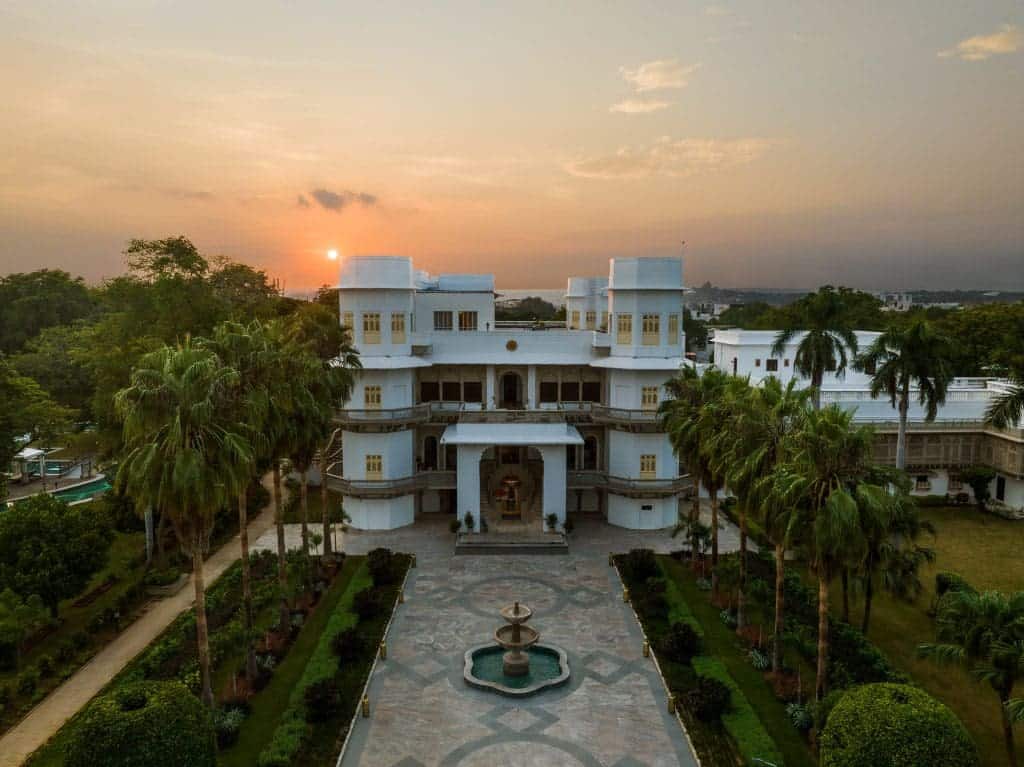
A Royal Legacy Intricately Carved
Commissioned by HH Maharaja Jayaji Rao Scindia 143 years ago, Taj Usha Kiran Palace, Gwalior, is a regal haven nestled in a 9-acre estate with fountains and pools. This magnificent retreat seamlessly blends the grandeur of Gwalior’s royal heritage with contemporary luxury in its 50 expansive rooms and suites adorned with intricate filigree work.
Guests have a chance to peer into the living history of this silent sentinel that reverberates with the city’s storied past and indulge in the finest traditions of Maratha royal life at the Palace, where regality, opulence, and contemporary luxury converge to craft an experience that is unique and unforgettable.
Named after the first light of the sun, the Palace is a beautiful sight. The inside of the Palace is decorated in warm earthy colours, and outside, there are well-kept gardens with palm trees, a large swimming pool, and smaller pools for children, all surrounded by bridges and moats.
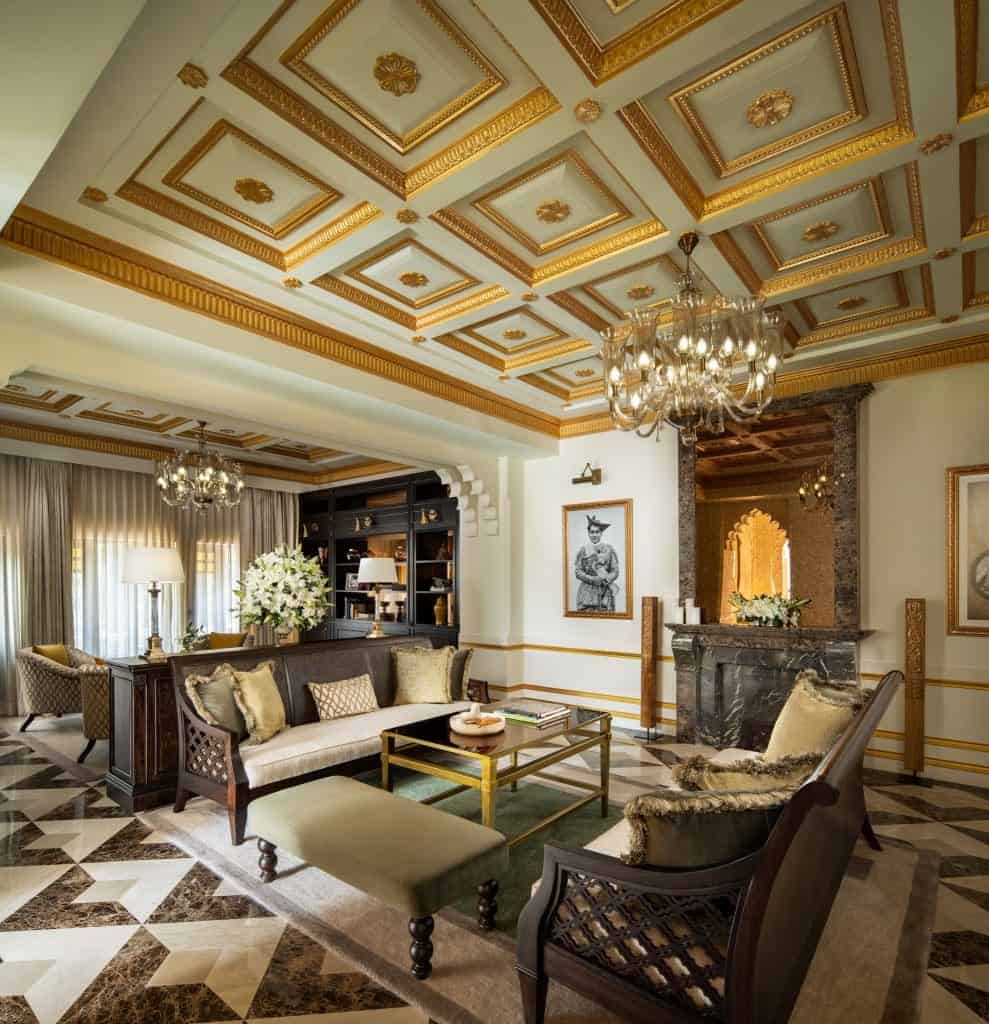
The hotel is an architectural marvel, featuring arched doorways, lattices, chandeliers, intricately carved pillars, and stained-glass windows. Its facade boasts intricate sandstone filigree, a remarkable feat in craft, offering a glimpse of the luxury within. This restoration carefully preserves the 19th-century royal splendour while incorporating modern comforts. It is wonderful to see how this 143-year-old realm of regality showcases intricate design, themed suites, acclaimed restaurants, the award-winning J Wellness Circle Spa and the enchanting Navtaal pool in its gardens.
The Palace offers some of the best dining experiences with a variety of food, including special royal recipes, hearty regional dishes, and international cuisine. These are served at the Silver Saloon, an all-day dining restaurant. For those looking to enjoy a drink, there’s the Bada Bar, a stylish and sophisticated place with a wide range of wines and liqueurs.
The Palace also boasts beautifully kept lawns that are perfect for big outdoor events. And for indoor gatherings, whether they’re corporate meetings or social events, the State Room is an ideal choice. This ballroom is designed to reflect the grandeur of royal times, making any event there feel special. It still features antique glass chandeliers,
handcrafted ceilings with decorative archways, and Venetian mirrors imported from Italy. These elements add to the grandeur of the hall.
The Palace Walk: A Legacy Tour
Before exploring the history of the Palace, Here is some background about the city of Gwalior. Can you guess how this city got its name?
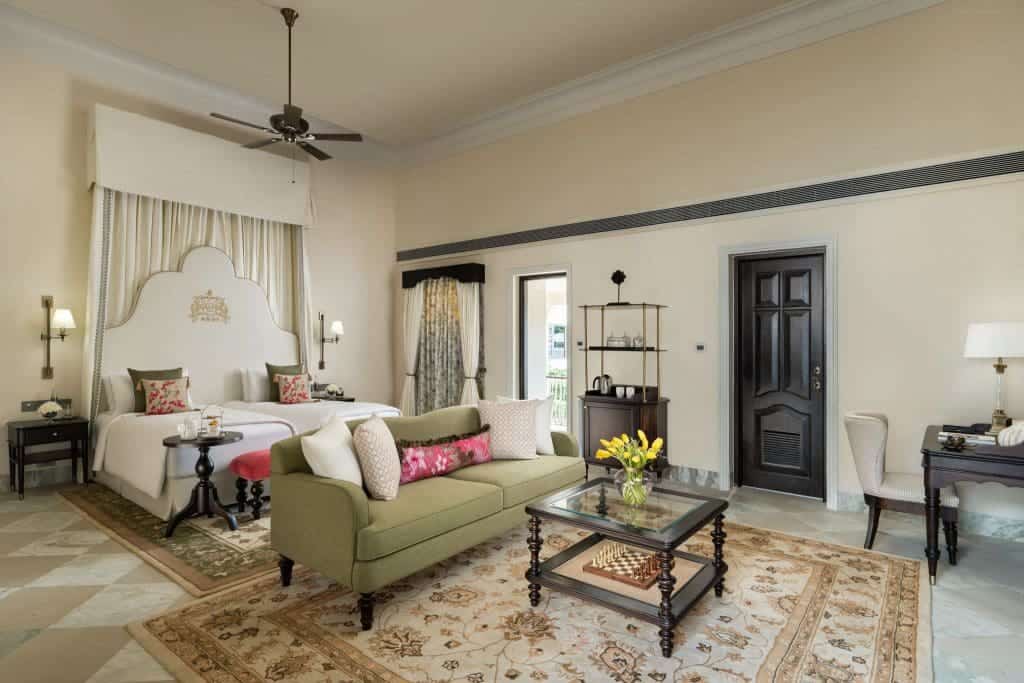
Legend has it that centuries ago, there was a saint named Gwalipa who resided here. One day, a Rajput chieftain named Suraj Sen, suffering from leprosy, passed through these lands. Gwalipa, the nearby hermit, insisted that Suraj Sen drink the water from a hilltop pool. Miraculously, after drinking the water, Suraj Sen was cured of leprosy. In gratitude, he built a fort on that hill, naming it Gwalior. The city that grew around the fort was also named Gwalior.
The Mughals lost Gwalior to the powerful Maratha clan of the Scindias, who have continued to work for the welfare of the people of Gwalior to this day. Speaking of the Scindian Dynasty, it was founded by Maharaj Ranoji Rao Scindia. His fifth and youngest son, Mahadaji Shinde, was bestowed the king’s turban after the third Battle of Panipat in 1761. Mahadji ’s claim to fame was his extraordinary achievement of conquering all the four erstwhile capitals of the Mughal Empire at different points of time, Agra, Fatehpur Sikri, Delhi and Lahore, in addition to the magnificent city of Gwalior and uniting India.
The Usha Kiran Palace was built as an annexe to the Jai Vilas Palace in the late 18th century by Maharaj Jayaji Rao Scindia. Initially called ‘Nav Talav’ or ‘Nine Tanks’ Palace, it stood on grounds with a network of canals, resembling a miniature version of Venice.
The current Maharaja of Gwalior is His Highness Maharaj Jyotiraditya Scindia, who serves the Government of India as the Minister of Civil Aviation and the Steel Ministry. He is the son of Maharaj Madhav Rao Scindia, who was also a cabinet minister and held various positions in the Government, such as Minister of Tourism, Civil Aviation, and Railways.
At the entrance of the Palace, you can see the bust of Maharaj Madho Rao Scindia, who hosted the Prince and Princess of Wales during their royal visit to India in 1905 at this very palace. He was responsible for revamping Usha Kiran Palace and transforming it into their guest house.
Out of the 100 guests in the Prince and Princess of Wales’ entourage, 40 were accommodated in Usha Kiran Palace, while the rest stayed in camps pitched to the South of the Palace, known as the Dilkusha Maidan. All 100 guests gathered at Taj Usha Kiran Palace for meals and social gatherings because the rooms were spacious enough to accommodate everyone. The Palace was specially built to welcome the King and Queen of England.
Speaking of the Palace’s architect, Sardar Sir Michael Filose, locally known as Mukhel Saheb, was commissioned by Maharaj Jayaji Rao Scindia to build the Jai Vilas Palace and later the Usha Kiran Palace in 1880. The Filose family, of Italian origin, had served the Scindia family since the early 1700s. Sir Michael Filose obtained his degree in Civil Engineering and Architecture from London University. The Scindia family held him in such high esteem that they ordered a large marble bust of Sir Michael Filose, which is still displayed at the Jai Vilas Palace Museum.
The Central Fountain and the Giant Cobra
The story behind the giant cobra in the Central fountain of the palace? This cobra has its own legend. The Scindian dynasty has a deep association with snakes, and it is evident throughout the palace. According to one belief, two cobras shielded the then Maharaja’s eyes from the sun while he rested in a field after a battle. Another version states that two snakes rested alongside the Maharaja after he returned from battle, preventing enemy soldiers from approaching him. The cobra became a symbol of Gwalior and is depicted on the state flag and royal emblem.
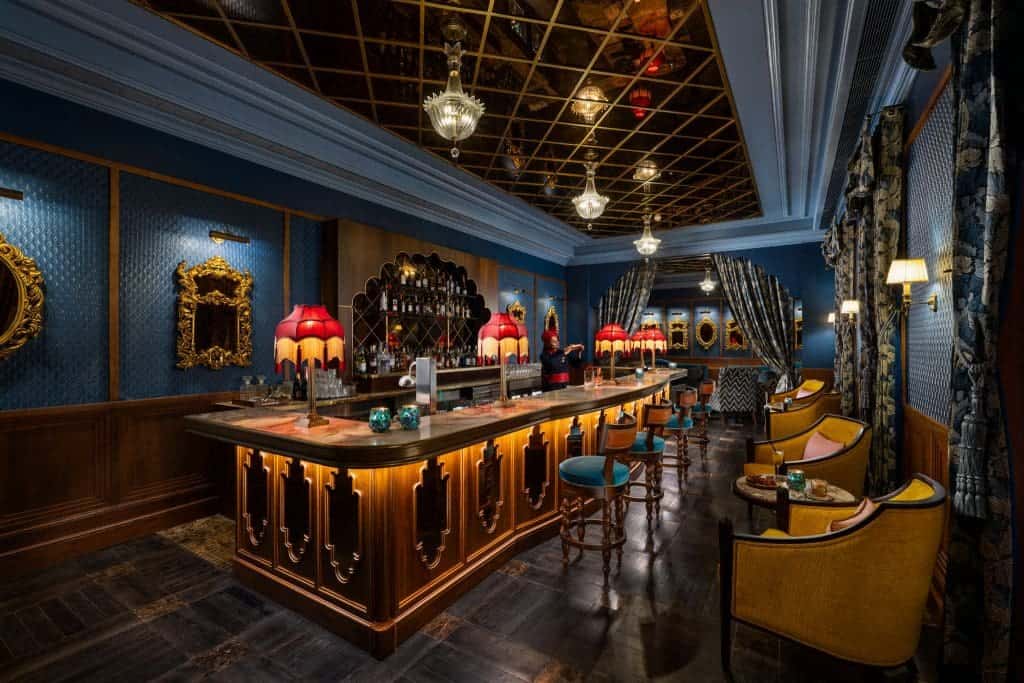
Moving on to the flora and fauna of the palace, the Phool Bagh is surrounded by lush green gardens, manicured lawns, and a variety of trees and plants. Here, you will find towering Ashoka, Banyan, Stone Apple, Java, and Neem trees, along with delicate flowering plants such as Hibiscus, Mogra, and Frangipani.
Filigree Wall Passage:
Taj Usha Kiran Palace takes inspiration from various architectural styles in India and Europe. One of the iconic features of this palace is the Filigree Wall, which is indigenous to Gwalior. This marvellous filigree corridor on the eastern side, enclosed with beautiful filigree work, is a testament to skilled labour, attention to detail, traditional tools, and dedicated craftsmen.
Jasmine Courtyard towards Bael Bagh
In 2004, the Taj Group introduced the first Jiva Spa Experience in this very palace. A section of the Radha Mahal was converted into three distinct massage therapy rooms, each offering a unique spa experience.
Today, the Taj has reimagined the J-Wellness Circle here at Usha Kiran Palace, offering a signature treatment exclusively for couples called Mangal Snaan. This treatment, native to Gwalior, allows couples to enjoy live, soothing music played by musicians seated behind a filigree screen in a special enclosure just outside the Mangal Snaan chamber.
Mangal Snaan dates back to the 15th-16th century, during the reign of Maan Singh Tomar. It was reserved for the Maharaja and his Maharani, earning the name ‘Royal Experience’ treatment. The Maharaja and Maharani would only undergo this massage before attending special ceremonies or engagements.
Visitors can also catch a glimpse of the Radha Mahal. Initially reserved for women only, Radha Mahal served as a designated bathing area for her Highnesses and the princesses. It was located in a secluded spot amidst nature. Occasionally, the Maharaja would visit the area to entertain his guests, and sometimes, he would even visit alone.
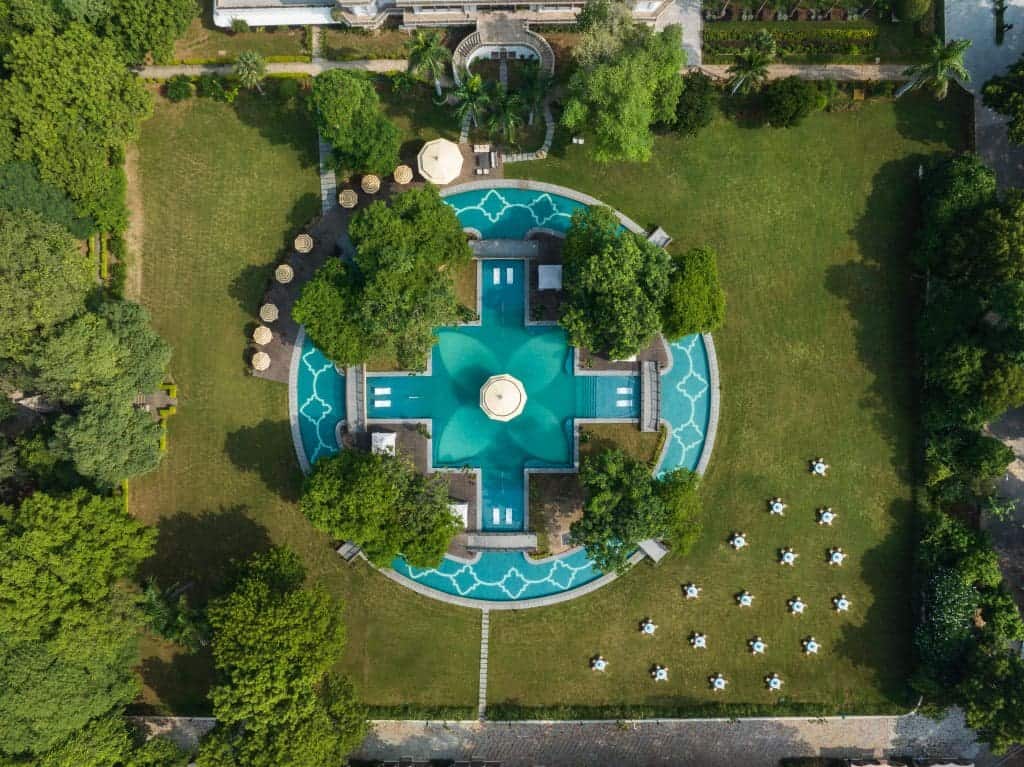
There used to be a secret underground passage connecting Jai Vilas Palace to Radha Mahal. Outside Radha Mahal, you will find the ‘ruins,’ a network of hidden tunnels and rooms. It was once used as a hunting lodge and later became a stable for horses. However, it was abandoned long before Usha Kiran Palace was built.
The Navtal Pool
This is the royal crest of the Scindia Dynasty. There are multiple interpretations of what the crown means; as per one of them, it means royalty of a Maharaja or his authority to rule and the towers represent Gwalior fort. A pair of wolves supports the crest from opposite sides, as grey wolves were commonly seen all over Gwalior at that time.
Squirrel Feeding Area:
Taj Usha Kiran Palace has a special squirrel feeding area, which is part of the palace activity. The Palace is also home to a variety of wildlife, including squirrels, mongooses, and various bird species such as Hummingbirds, Peacocks, Sparrows, Parrots, Woodpeckers, and Pigeons.
Lord Ganesh Temple:
This Ganesh Temple is approximately 130 years old. The palace`s in-house pandit performs puja here every morning and evening.
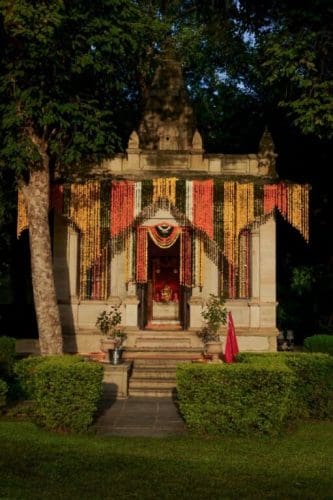
Lord Shiva Temple:
The statue of Lord Shiva over there is around 130 years old. If you observe closely, you’ll notice that Lord Shiva’s entire family is carved into the stone. This idol has a fascinating history. Originally, it was carved out of a single stone and used as a water fountain.
Legend has it that this Shiva statue was meant to be placed in the temple ahead. However, as the temple was incomplete when the statue arrived, it was temporarily kept under the banyan tree. When the temple was finally completed, the statue got chipped during the moving process. Fearing ill fate and bad omens, the chipped statue was not placed inside the new temple. Instead, an open area was built into a temple to house the deity.
Letter Box and Rosewood Elevator:
In the lobby, there is a wooden letter box installed by Maharaj Scindia to allow his service team to communicate with their relatives and friends.
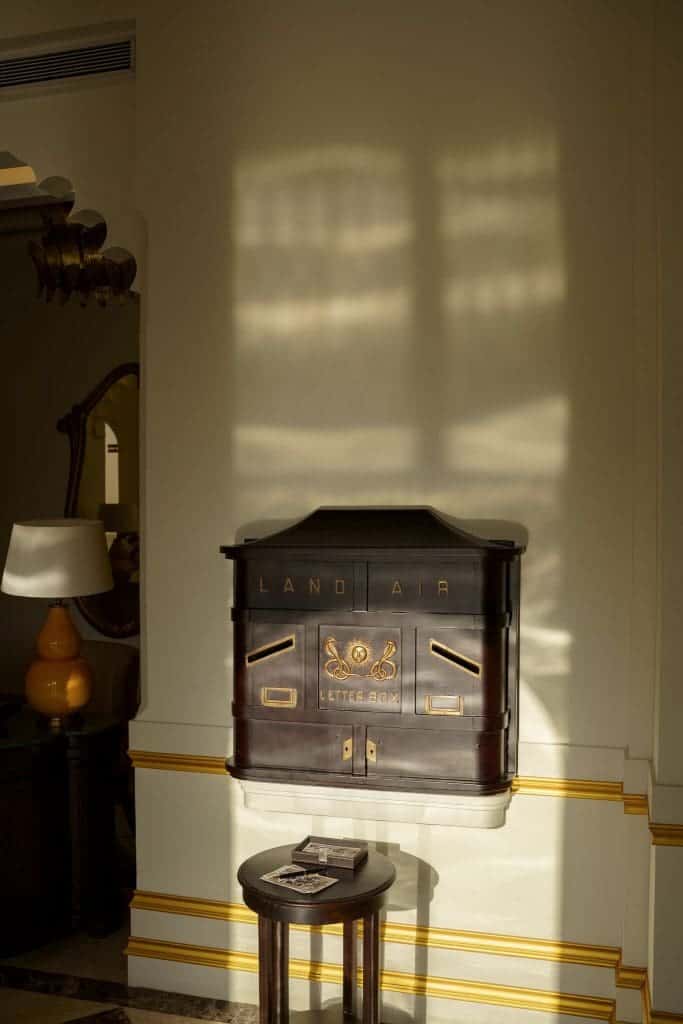
Also, the 93-year-old Marryat & Scott Ltd. rosewood elevator was imported from London in 1930. It retains its original rosewood craftsmanship.
Tombs of Sandy and Winny:
The grandfather of the current Maharaja, Maharaj George Jivaji Rao Scindia, had a deep affection for his dogs, Sandy and Winny, who were the leaders of the dog house located near the villas. In their memory, he built two small tombs, as can be seen in the Palace grounds.
At the end of their stay, guests at The Taj Usha Kiran Palace Hotel are quick to acknowledge that indeed the hotel stands as a testament to the rich tapestry of history and culture in Gwalior. The Taj Usha Kiran Palace is not just a stay experience; it’s a journey through time, wrapped in the comfort of contemporary luxury, making every moment spent here a cherished memory.
Read more: Latest



